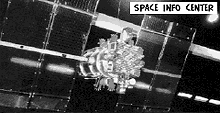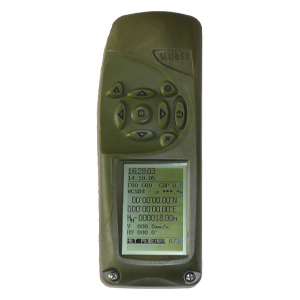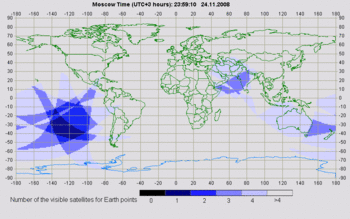گلوناس
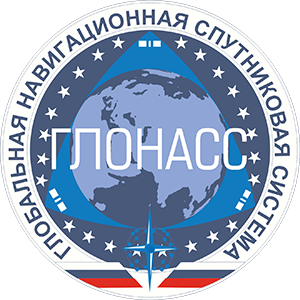 GLONASS logo | |
| بلد المنشأ | Russia |
|---|---|
| المشغل | Roscosmos |
| النوع | Military, civilian |
| الوضع | Operational |
| التغطية | Global |
| الدقة | 4.5–7.4 meters |
| حجم الكوكبة | |
| إجمالي السواتل | 27 |
| السواتل في المدار | 24 |
| أول إطلاق | October 1982 |
| آخر إطلاق | May 28, 2016 |
| السمات المدارية | |
| النظام | 3x MEO |
| الارتفاع المداري | 19,130 km |
| جيوديسيا | ||||||||||||||||||||||
|---|---|---|---|---|---|---|---|---|---|---|---|---|---|---|---|---|---|---|---|---|---|---|
 | ||||||||||||||||||||||
| أساسيات | ||||||||||||||||||||||
| مفاهيم | ||||||||||||||||||||||
| تقنيات | ||||||||||||||||||||||
|
معايير
| ||||||||||||||||||||||
گلوناس (روسية: ГЛОНАСС، اختصار ГЛОбальная НАвигационная Спутниковая Система; بالحروف اللاتينية: GLObal'naya NAvigatsionnaya Sputnikovaya Sistema; "GLObal NAvigation Satellite System" in English)، هو نظام سواتل الملاحة العالمية Global Navigation Satellite System (GNSS)، تم تطويره من قبل الاتحاد السوفيتي السابق، وتديره الآن الحكومة الروسية عن طريق قوات الفضاء الروسية. وهو بديل ومشابه لنظام تحديد المواقع العالمي الأمريكي، ونظام گاليليو للتموقع Galileo positioning system الاوروبي المزمع، نظام الملاحة كومپاس COMPASS navigation system الصيني المقترح، ونظام السواتل الملاحية الإقليمي الهندي IRNSS.
بدأ تطوير گلوناس في 1976، بهدف التغطية العالمية بحلول 1991. في في 12 اكتوبر 1982، تم إطلاق أعداد من الصواريخ لتضاف لسواتل النظام حتى اكتملت المجموعة في 1995. بعد الانتهاء من المرحلة، سرعان ما سقط النظام بسبب الانهيار الذي الم بالاقتصاد الروسي.
في بداية 2001، عادت روسيا للعمل على تطوير النظام مرة أخرى، وفي السنوات الأخيرة تقدمت الحكومة الهندية بعرض شراكة في النظام، ومن المتوقع أن يبدأت العمل بالنظام على النطاق العالمي بحلول 2009.[1]
وصف النظام

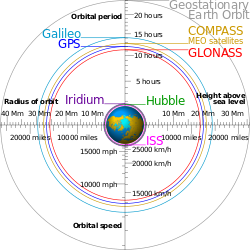
الغرض
GLONASS was developed to provide real-time position and velocity determination, initially for use by the Soviet military for navigation and ballistic missile targeting. It was the Soviet Union's second generation satellite navigation system, improving on the تسيكلون system which required one to two hours of signal processing to calculate a location with high accuracy. By contrast, once a GLONASS receiver is tracking the satellite signals, a position fix is available instantly. It is stated that at peak efficiency the system's standard positioning and timing service provide horizontal positioning accuracy within 57–70 meters, vertical positioning within 70 meters, velocity vector measuring within 15 cm/s, and time transfer within 1 µs (all within 99.7% probability).[2]
الخصائص المدارية
منظومة گلوناس كاملة التشغيل تتكون من 24 ساتل، منهم 21 مستخدمون لنقل الإشارات وثلاثة سواتل احتياطية في المدار، منشورون في ثلاثة مستويات مدارية. The three orbital planes' ascending nodes are separated by 120° with each plane containing eight equally spaced satellites. The orbits are roughly circular, with an inclination of about 64.8°, and orbit the Earth at an altitude of 19،100 km (11،868 mi), which yields an orbital period of approximately 11 hours, 15 minutes. The planes themselves have a latitude displacement of 15°, which results in the satellites crossing the equator one at a time, instead of three at once. The overall arrangement is such that, if the constellation is fully populated, a minimum of five satellites are in view from any given point at any given time.
Each satellite is identified by a "slot" number, which defines the corresponding orbital plane and the location within the plane; numbers 1–8 are in plane one, 9–16 are in plane two, and 17–24 are in plane three.
A characteristic of the GLONASS constellation is that any given satellite only passes over the exact same spot on the Earth every eighth sidereal day. However, as each orbit plane contains eight satellites, a satellite will pass the same place every sidereal day. For comparison, each GPS satellite passes over the same spot once every sidereal day.
الاشارات
يعمل نظام گلوناس على نقل نوعين من الإشارات: a standard precision (SP) signal and an obfuscated high precision (HP) signal.
All satellites transmit the same code as their SP signal, however each transmits on a different frequency using a 15-channel frequency division multiple access (FDMA) technique spanning either side from 1602.0 MHz, known as the L1 band. The center frequency is 1602 MHz + n × 0.5625 MHz, where n is a satellite's frequency channel number (n=−7,−6,−5,...,7). Signals are transmitted in a 38° cone, using right-hand circular polarization, at an EIRP between 25 to 27 dBW (316 to 500 watts). Note that the 24 satellite constellation is accommodated with only 15 channels by using identical frequency channels to support antipodal (opposite side of planet in orbit) satellite pairs, as these satellites will never be in view of an earth based user at the same time.
The HP signal is broadcast in phase quadrature with the SP signal, effectively sharing the same carrier wave as the SP signal, but with a ten times higher bandwidth than the SP signal.
The L2 signals use the same FDMA as the L1 band signals, but transmit straddling 1246 MHz with the center frequency determined by the equation 1246 MHz + n×0.4375 MHz, where n spans the same range as for L1.[3] Other details of the HP signal have not been disclosed.
At peak efficiency, the SP signal offers horizontal positioning accuracy within 5–10 meters, vertical positioning within 15 meters, a velocity vector measuring within 10 cm/s, and timing within 200 ns, all based on measurements from four satellite signals simultaneously (this reference is outdated, as it's based on URAGAN satellites while the current constellation is 18/19 URAGAN-M satellites.[2] The more accurate HP signal is available for authorized users, such as the Russian Military, yet unlike the US P(Y) code which is modulated by an encrypting W code, the GLONASS P codes are broadcast in the clear using only 'security through obscurity'. Use of this signal bears risk however as the modulation (and therefore the tracking strategy) of the data bits on the L2P code has recently changed from unmodulated to 400bps burst at random intervals. The GLONASS L1P code is modulated at 50bps without a manchester meander code, and while it carries the same orbital elements as the CA code, it allocates more bits to critical Luni-Solar acceleration parameters and clock correction terms.
Currently, an additional civil reference signal is broadcast in the L2 band with an identical SP code to the L1 band signal. This is available from all satellites in the current constellation, except satellite number 795 which is the last of the inferior original GLONASS design, and one partially inoperable GLONASS-M satellite which is broadcasting only in the L1 band. (see glonass-ianc.rsa.ru for daily updates on constellation status.)
GLONASS uses a coordinate datum named "PZ-90" (Earth Parameters 1990 - Parametry Zemli 1990), in which the precise location of the North Pole is given as an average of its position from 1900 to 1905. This is in contrast to the GPS's coordinate datum, WGS 84, which uses the location of the North Pole in 1984. As of September 17, 2007 the PZ-90 datum has been updated to differ from WGS 84 by less than 40 cm (16 in) in any given direction.
السواتل
As with GLONASS's predecessor program, Tsiklon, GLONASS satellites are developed under the leadership of the JSC Information Satellite Systems (formerly called NPO PM), with the assistance of the Institute for Space Device Engineering (ru:РНИИ КП) and the Russian Institute of Radio navigation and Time. Serial production of the satellites is primarily accomplished by the company PC Polyot.
Over the three decades of development, the satellites themselves have gone through numerous revisions, separated here as generations. The name of each satellite was Uragan (إنگليزية: hurricane), followed either by a number for operational satellites or by an acronym GVM (روسية: габаритно-весовой макет; إنگليزية: size weight dummy) for test satellites. All Uragan satellites had a GRAU designation 11F654, and each of them also had the usual ordinal "Cosmos-NNNN" designation.[4]
النماذج (الجيل صفر)
The first GLONASS vehicles to be launched, referred to as Block I vehicles, were prototypes and GVM dummy vehicles. Three dummies and 18 prototypes were launched between 1982 and 1985. Designed to last only one year, they averaged an actual lifetime of 14 months.
الجيل الأول
The true first generation of Uragan satellites were all 3-axis stabilized vehicles, generally weighing 1,250 kg and were equipped with a modest propulsion system to permit relocation within the constellation. Over time they were divided into Block IIa, IIb, and IIv vehicles, with each block containing evolutionary improvements
Six Block IIa satellites were launched in 1985–1986 with improved time and frequency standards over the prototypes, and increased frequency stability. These spacecraft also demonstrated a 16-month average operational lifetime. Block IIb spacecraft, with a 2-year design lifetimes, appeared in 1987, of which a total of 12 were launched, but half were lost in launch vehicle accidents. The six spacecraft that made it to orbit worked well, operating for an average of nearly 22 months.
Block IIv was the most prolific of the first generation. Used exclusively from 1988 to 2000, and continued to be included in launches through 2005, a total of 25 satellites were launched. The design life was three years, however numerous spacecraft exceeded this, with one late model lasting 68 months.[5]
Block II satellites were typically launched three at a time from the Baikonur Cosmodrome using Proton-K Blok-DM-2 or Proton-K Briz-M boosters. The only exception was when, on two launches, an Etalon geodetic reflector satellite was substituted for a GLONASS satellite.
الجيل الثاني
The second generation of satellites, known as Uragan-M (also called GLONASS-M), were developed beginning in 1990 and first launched in 2001.
These satellites possess a substantially increased lifetime of seven years and weigh slightly more at 1,480 kg. They are approximately 2.4 m (7 ft 10 in) in diameter and 3.7 m (12 ft) high, with a solar array span of 7.2 m (24 ft) for an electrical power generation capability of 1600 watts at launch. The aft payload structure houses 12 primary antennas for L-band transmissions. Laser corner-cube reflectors are also carried to aid in precise orbit determination and geodetic research. On-board cesium clocks provide the local clock source.
A total of fourteen second generation satellites were launched through the end of 2007. As with the previous generation, the second generation spacecraft were launched in triplets using Proton-K Blok-DM-2 or Proton-K Briz-M boosters.
Third generation
The third generation satellites are known as Uragan-K (GLONASS-K) spacecraft. These satellites are designed with a lifetime of 10 to 12 years, a reduced weight of only 750 kg, and offer an additional L-Band navigational signal. As with the previous satellites, these are 3-axis stabilized, nadir pointing with dual solar arrays. They will enter service in 2009.
Due to their weight reduction, Uragan-K spacecraft can be launched in pairs from the Plesetsk Cosmodrome launch site using the substantially lower cost Soyuz-2 boosters or in six-at-once from the Baikonur Cosmodrome using Proton-K Briz-M launch vehicles.
التحكم الأرضي
The ground control segment of GLONASS is entirely located within former Soviet Union territory. The Ground Control Center and Time Standards is located in Moscow and the telemetry and tracking stations are in Saint Petersburg, Ternopol, Eniseisk, Komsomolsk-na-Amure.[6]
المستقبلات
Septentrio, Topcon, JAVAD, Magellan Navigation, Novatel, Leica Geosystems and Trimble Inc produce GNSS receivers making use of GLONASS. NPO Progress describes a receiver called "GALS-A1" which combines GPS and GLONASS reception.
الوضع الحالي
في فبراير 2009، ضم نظام گلوناس على 20 ساتل، منهم 19 ساتل عامل، وواحد تحت الصيانة. يتطلب النظام 19 ساتل لتغطية خدمات الملاحة المستمرة على الأراضي الروسية، و24 ساتل لتغطية الخدمات على مستوى العالم.[7][8]
يغطي گلوناس 100% من الأراضي الروسية.[9]
التاريخ
التطوير من قبل الاتحاد السوفيتي
In the late 1960s and early 1970s, the Soviet Union identified the need and benefits of developing a new satellite-based radio navigation system. Their existing Tsiklon satellite navigation system, while highly accurate for stationary or slow-moving ships, required several hours of observation by the receiving station to fix a position, making it unusable for many navigation purposes and for the guidance of the new generation of ballistic missiles.
From 1968 to 1969, the research institutes of the Ministry of Defence, Academy of Sciences, and Soviet Navy cooperated to develop a single system for navigation of their air, land, sea, and space forces. This collaboration resulted in a 1970 document that established the requirements for such a system. Six years later, in December 1976, a plan for developing GLONASS was accepted in a Decision of the Central Committee of the CPSU and of the Council of Ministers of the USSR entitled "On Deployment of the Unified Space Navigation System GLONASS."
From 1982 through April 1991, the الاتحاد السوڤيتي successfully launched a total of 43 GLONASS-related satellites plus five test satellites. In 1991, twelve functional GLONASS satellites in two planes were available; enough to allow limited usage of the system.
تأخر الإنجاز
Following the disintegration of the الاتحاد السوڤيتي in 1991, continued development of GLONASS was undertaken by the Russian Federation. It was promised to be operational on September 24, 1993 by then-president Boris Yeltsin, however the constellation was not completed until December 1995.
In the six years following completion, Russia was unable to maintain the system. By April 2002, this resulted in only eight satellites remaining in operation, which rendered the system almost useless as a global navigation aid.
الإحياء والتحديث
With GLONASS falling rapidly into disrepair, a special-purpose federal program named "Global Navigation System" was undertaken by the Russian government on August 20, 2001. According to it, the GLONASS system was to be restored to fully deployed status (i.e. 24 satellites in orbit and continuous global coverage) by 2011.[10]
The New York Times reported in April 2007 that Russia had committed to accelerated launches, with eight satellites scheduled to be orbited in 2007 and a goal of reaching global coverage in 2009.[1] Microcom Systems reported on its website that two launches, in September and December 2007, would lift the final six second-generation satellites, and that April 2008 will see the first launch of two third-generation satellites.[11]
The 2007 launches occurred on 26 October and 25 December. Both launches were successful, orbiting six satellites altogether. Following the launches, Russia's First Deputy Prime Minister Sergei Ivanov predicted that the launches would bring the GLONASS satellite fleet to up 18 satellites, the number necessary to provide navigation services over the entire Russian territory, and repeated that the system would have the required 24 satellites for worldwide coverage by 2010.[12] Once all of these satellites are fully commissioned and set to healthy, GLONASS signals will be available across 90 percent of Russia and 80 percent of the globe, according to RISDE.[بحاجة لمصدر]
Six new GLONASS satellites were added to the network in 2008.[7] The first third generation (GLONASS-K) satellites are set to be launched in 2009, according to RIA Novosti.[13] The head of Russian Space Agency, Anatoly Perminov said in September, 2008, that the number of satellites in the GLONASS network would be increased to 30 by 2011.[7]
التعاون مع الحكومة الهندية
في يناير 2004 أعلنت وكالة الفضاء الروسية (RSA) عن توقيع اتفاق مع وكالة الفضاء الهندية، منظمة أبحاث الفضاء الهندية، حيث ستتعاون الوكالتان الحكوميتان من أجل collaborate to restore the system to constant coverage of Russian and Indian territory بحلول 2008 بواسطة 18 ساتل، ويتم تشغيل النظام بالكامل عن طريق 24 ساتال بحلول 2010.[14]
أعلنت التفاصيل في منتصف 2005 والتي أفادت بأن روسيا ستقوم ببناء السواتل وفي الفترة من 2006 حتى 2008 سوف يتم إطلاق ساتلين من مركز فضاء ساتيش دوان في ولاية ندرا پرادش، بالهند، باستخدام نظام صواريخ Geosynchronous Satellite Launch Vehicle (GSLV) الهندي.[15] As of April 2007, India has yet to launch any satellites as part of this project.
أثناء قمة ديسمبر 2005 اتفق رئيس وزراء الهند مانموهان سنغ والرئيس الروسي ڤلاديمير پوتن، أن الهند سوف تشارك في بعض تكاليف تطوير سلسلة گلوناس-ك وإطلاق إثنان من السواتل الجديدة من الهند، in return for access to the HP signal.
المناقشات مع الحكومة الأمريكية
في أعقاب اجتماع ديسمبر 2006 في موسكو لمجموعة GPS-GLONASS Interoperability and Compatibility Working Group (WG-1)، أعلن في الموقع الإلكتروني للحكومتين الأمريكية والروسية أن كلا الجانبين had made significant progress in understanding the benefit to the user community of changing GLONASS to a signal pattern that is in common with GPS and Galileo.[16] A change in the GLONASS system from its current FDMA technique to the GPS and Galileo's CDMA format would enable a simply-designed receiver to use both satellite systems simultaneously.
GPSWorld reported that the group had met twice prior to then and that the working group would likely make an announcement when they meet again in April 2007, during the International Satellite Forum 2007 in Moscow.[17] However no announcement was made.
المناقشات مع كوبا وڤنزويلا
يمكن لروسيا أن تشرك كوبا وڤنزويلا في نظام الملاحة الفضائية المصمم في الأصل من أجل الصواريخ المستخدمة بواسطة العسكرية السوڤيتية، وقال رئيس وكالة الفضاء الروسية "ناقشنا موضوع الاستخدام المشترك لنظام الملاحة الفضائية گلوناس"، Roskosmos chief Anatoly Perminov was quoted by RIA Novosti news agency as saying, referring to talks with officials in Venezuela.[18]
إتاحة الإشارات المدنية رسميا
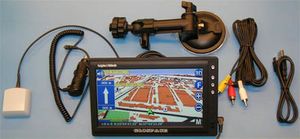
On May 18, 2007, Russian president Vladimir Putin signed a decree officially providing open access to the civilian navigation signals of the GLONASS system, to Russian and foreign consumers, free of charge and without limitations. The Russian president also directed the Federal Space Agency to coordinating work to maintain, develop and enable the system for civilian and commercial needs.[19]
Additionally, Mr. Putin acquired a GLONASS-enabled collar for his black Labrador, Koni, as an afterthought of using GLONASS to monitor cattle and animals in the wild.[20]
انظر أيضا
- نظام سواتل ملاحة عالمي - المصطلح العام المستخدم لوصف نظام التموقع العالمي
- Multilateration - التقنية الرياضية المستخدمة للتموقع
هوامش ومصادر
- ^ أ ب Kramer, 2007
- ^ أ ب "A Review of GLONASS" Miller, 2000
- ^ GLONASS transmitter specs
- ^ Uragan, Russian Space Web
- ^ GLONASS #787, 68.7 operational months; as reported by RSA "GLONASS constellation status" on 6 April 2007
- ^ GLONASS Summary, Space and Tech
- ^ أ ب ت Russia to set world record with 39 space launches in 2009 RIA Novosti 2008-12-29
- ^ "GLONASS constellation status..." RSA, 2008
- ^ http://www.interfax.ru/society/news.asp?id=62659
- ^ Russian Government, 2001
- ^ Microcom Systems' Launch Schedule. Accessed September 1, 2007.
- ^ "Russian Launches..." Space.com / AP, 2007
- ^ GLONASS system to consist of 30 satellites. Accessed 2008-05-21.
- ^ "Russian space agency plans..." MosNews, 2004
- ^ "India to launch..." MosNews, 2005
- ^ "Joint announcement..." GPS/GLONASS, 2006
- ^ "Radical change..." GPS World, 2007
- ^ نازداك: كوبا وڤنزويلا قد ينضما إلى گلوناس
- ^ "The services of system..." Ria Novosti, 2007
- ^ Putin's dog gets a satellite collar. Accessed 2008-10-16.
بيبليوگرافيا
- "ФЕДЕРАЛЬНАЯ ЦЕЛЕВАЯ ПРОГРАММА "ГЛОБАЛЬНАЯ НАВИГАЦИОННАЯ СИСТЕМА" إنگليزية: FEDERAL SPECIAL-PURPOSE PROGRAM "GLOBAL NAVIGATION SYSTEM"[[Category:Articles containing إنگليزية-language text]][[Category:Pages using Lang-xx templates]]". Russian Federal Government (in Russian). 2001-08-20. Retrieved 2007-04-10.
{{cite web}}: URL–wikilink conflict (help)CS1 maint: unrecognized language (link)
- "GLONASS constellation status for 18.01.08 under the analysis of the almanac and accepted in IANC (UTC)". Russian Space Agency (RSA). Retrieved 2008-01-18.
- "GLONASS Summary". Space and Tech. Retrieved 2007-04-12.
- "GLONASS Transmitter Specifications". Retrieved 2007-04-13.
- Goebel, Greg. "Navigation Satellites & GPS". pp. Section 2.2. Retrieved 2007-04-10.
- "Интегральная доступность навигации наземного потребителя по системе ГЛОНАСС إنگليزية: Integral accessibility of the navigation of ground-based user along the system GLONASS[[Category:Articles containing إنگليزية-language text]][[Category:Pages using Lang-xx templates]]". Russian Space Agency (RSA) (in Russian). Retrieved 2008-01-18.
{{cite web}}: URL–wikilink conflict (help)CS1 maint: unrecognized language (link)
- "India joins Russian GPS system". The Times of India. 2007-01-29. Retrieved 2007-04-12.
- "India to Launch 2 Russian GLONASS Satellites". MosNews. 2005-06-27. Retrieved 2007-04-12.
- "Joint announcement (in English and Russian)". GPS/GLONASS Interoperability and Compatibility Working Group. 2006-12-14. Retrieved 2007-04-13.
- Kramer, Andrew E. (2007-04-07). "Russia Challenges the U.S. Monopoly on Satellite Navigation". New York Times. Retrieved 2007-04-12.
- Miller, Keith M. (2000). "A Review of GLONASS". Hydrographic Society Journal. Retrieved 2007-04-13.
{{cite journal}}: Cite journal requires|journal=(help); Unknown parameter|month=ignored (help)
- "Radical Change in the Air for GLONASS". GPS World. 2007-01-22. Retrieved 2007-04-10.
- "Russia Allocates $380 Million for Global Navigation System in 2007". MosNews. 2007-03-26. Retrieved 2007-04-12.
- "Russia Holds First Place in Spacecraft Launches". MosNews. 2007-03-26. Retrieved 2007-04-12.
- "Russia Launches New Navigation Satellites into Orbit". Space.com / Associated Press. 2007-12-25. Retrieved 2007-12-28.
- "Russian Space Agency Plans Cooperation With India". MosNews. 2004-01-12. Retrieved 2007-04-12.
- "Space Policy Project's "World Space Guide: GLONASS"". Federation of American Scientists. Retrieved 2007-04-10.
- "Услуги системы ГЛОНАСС будут предоставляться потребителям бесплатно إنگليزية: The services of system GLONASS will be given to users free of charge[[Category:Articles containing إنگليزية-language text]][[Category:Pages using Lang-xx templates]]" (in Russian). RIA Novosti. 2007-05-18. Retrieved 2007-05-18.
{{cite news}}: URL–wikilink conflict (help)CS1 maint: unrecognized language (link)
- "Три КА «Глонасс-М» взяты на управление إنگليزية: Three KA "GLONASS-M" have taken off[[Category:Articles containing إنگليزية-language text]][[Category:Pages using Lang-xx templates]]". Russian Space Agency (RSA) (in Russian). 2006-12-26. Retrieved 2006-12-29.
{{cite web}}: URL–wikilink conflict (help)CS1 maint: unrecognized language (link)
- "Uragan (GLONASS, 11F654)". Gunter's Space Page. 2007-01-16. Retrieved 2007-04-10.
- "Uragan navsat (11F654)". Russian Space Web. Retrieved 2007-04-12.
- "GLONASS News". Retrieved 2007-07-31.
وصلات خارجية
- Official GLONASS web page
- GNSS web page including GLONASS
- Description of GLONASS on the web page of the International Laser Ranging Service (ILRS)
- GLONASS: present, future and past Presented on the ILRS Technical Workshop, 14–19 September 2009, Metsovo, Greece
- A homemade receiver for GPS & GLONASS satellites
- Navipedia information on GLONASS—Wiki initiated by the European Space Agency
خطأ استشهاد: وسوم <ref> موجودة لمجموعة اسمها "lower-alpha"، ولكن لم يتم العثور على وسم <references group="lower-alpha"/>
- Articles containing روسية-language text
- Pages using Lang-xx templates
- Articles containing إنگليزية-language text
- مقالات ذات عبارات بحاجة لمصادر
- CS1 errors: URL–wikilink conflict
- CS1 errors: unsupported parameter
- گلوناس
- برنامج الفضاء الروسي
- برنامج الفضاء السوڤيتي
- Satellite navigation systems
- أنظمة سواتل ملاحة عالمية
- اختراعات سوڤيتية
